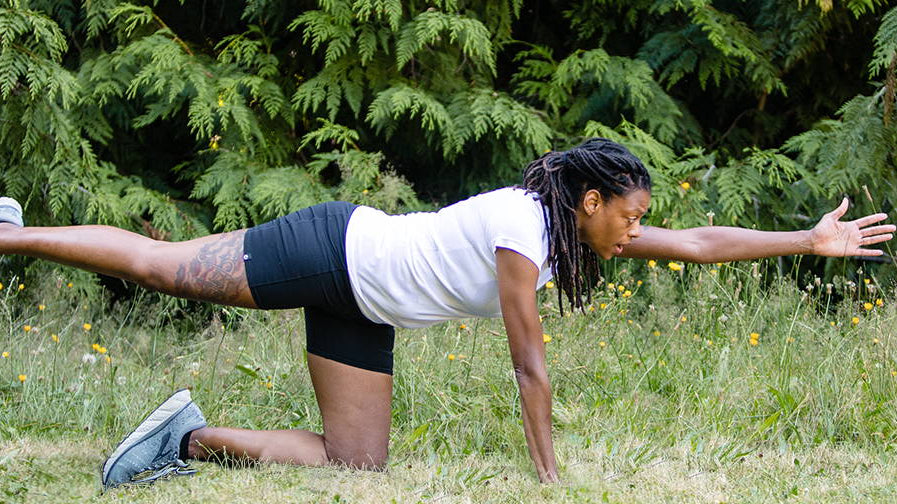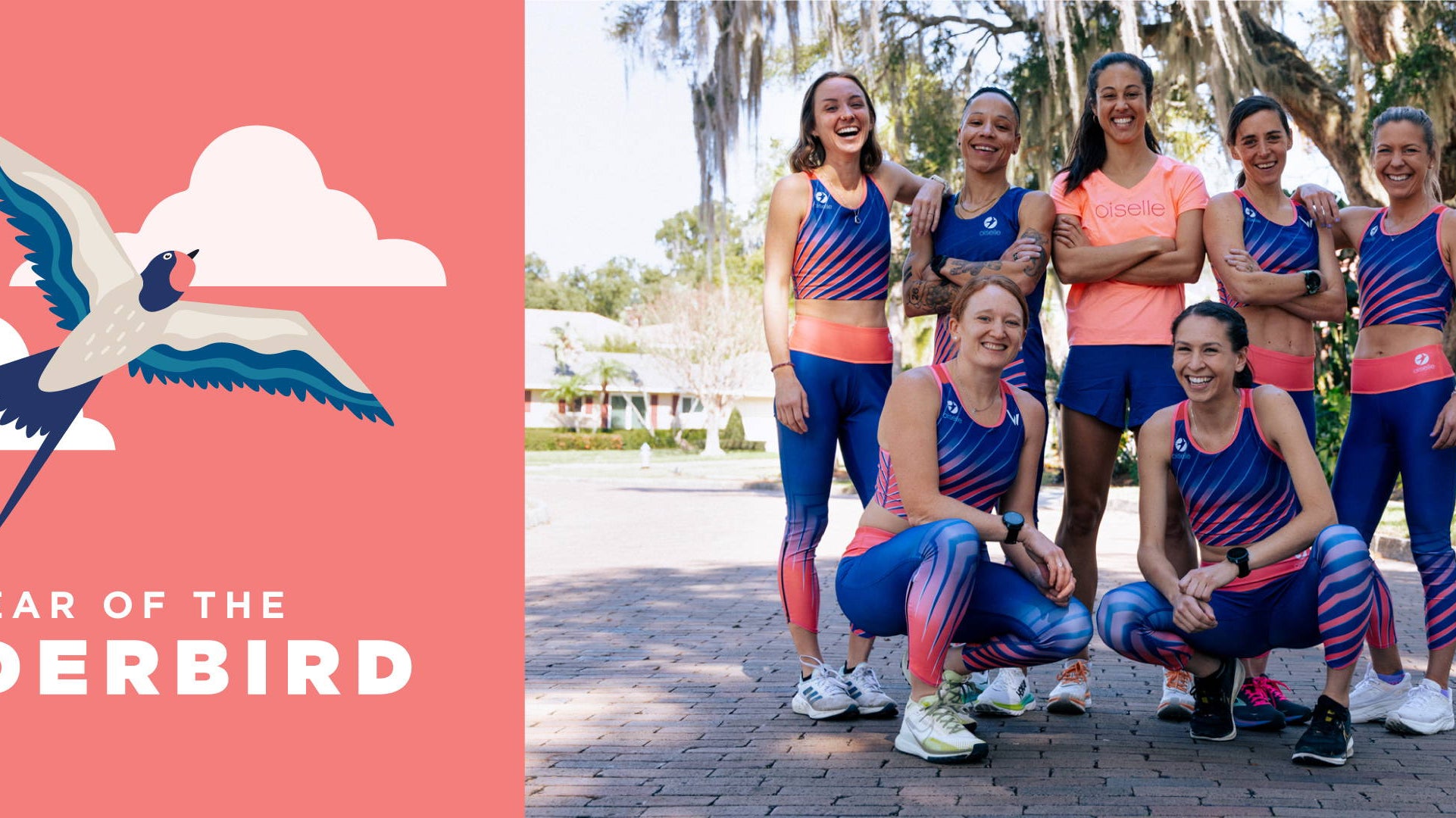Our amazing Nesters Anita (Customer Care, All-American at the University of Washington) and Mo (Design, Steepler at Kent State) are working together in another way: coaching a local high school cross country team! And they’ve got some great XC wisdom to share for athletes and parents alike.
Cross-country season is officially in full swing and I have never been shy about admitting that it’s my favorite time of the year. I love that XC isn’t fancy. I love that it can get dirty and cold and keeps the focus on the competition itself vs. fast times and flat tracks. It might get ugly sometimes, and that’s the point. Since my early high school days, the changing of summer to fall is marked by a return to afternoon practices and the change back to long sleeves and tights. I don’t know exactly what that ‘fall smell’ is on the trails, but when you smell it, you know it’s go time!
Nester Anita above, on the podium in second place!
My love of cross-country season has found me coaching at the collegiate, high school and middle school levels over the past 5 years. It’s important to me to help celebrate and encourage this corner of our sport. Deena Kastor wrote it best in her book, Let Your Mind Run: “Anything that you have, whether it be time or knowledge or money or food on the table, it’s true value increases the moment It’s shared.” I will be coaching HS XC with a team of over 80 young women and am consistently reminded of how much I have learned from my past experiences and how much I still have to learn in the future. Whether you’re a HS coach, HS athlete or parent of an athlete, I hope you find some of these tips and reminders helpful for the season ahead!
Tear it up!
Anita
Nester Mo digging deep in the "Appleton West" jersey.
Every year when fall comes around the average person thinks pumpkins, apple cider and Halloween. I think cross-country season. This sport is gritty, dirty and an all-around great time. It is an opportunity to really dig deep within yourself and find your strengths -- physically and mentally. Not only does it teach you these strengths, it also teaches you teamwork and accountability. Though this is an individual sport, every person out there on the course matters. Lifting your teammates up is so important to creating amazing successes towards the end of the year.
This is a lifelong sport, and even though I am a new coach and still in my early 20s I know that’s going to be the case for me. I ran through both middle school and high school and then competed for Kent State in college. This season I hope to not only learn from coaching alongside Anita, but I also hope to pass all the knowledge from my former coaches down to these athletes! This sport is a special one, and as a former athlete I am excited to help lift the next generation of runners by helping them feel strong and fast. Good luck to all the students and thank you, parents, for encouraging your kids and cheering them on in this awesome sport!
Head Up, Wings Out!
Mo
TIPS FOR COACHES + PARENTS
- Be patient and have long-term perspective. If I’m doing this right as a coach, I will be able to look 20 years into the future and see athletes still wanting to line up on starting lines with their friends, family or co-workers, enjoying racing and the joy it can bring. Good things in sport take time and it’s important to encourage athletes to maintain long term perspective when it comes to running and training.
- Health of athletes is your top priority. Young athletes are still growing, learning, and riding the highs and lows of teenage years. This can be an extremely rewarding but also stressful time in their lives. Above everything else, it’s important that they understand there can be negative effects to being short sighted in sport, especially during developmental teenage years.
- Prioritize a commitment to the process. In order to help each athlete search for their ultimate potential in this sport, it’s important to lead with value placed on commitment to consistent, uninterrupted training through the season. High school athletes are busy! But by explaining the importance of consistency and helping them understand training, you are more likely to find buy-in over the course of a 9 to 11-week season.
- Encourage access to a physical therapist for preventative PT. Not everyone will have access to a PT, and that’s okay. But if there’s a chance that an athlete can work with a PT in their high school years to evaluate weaknesses and strengths, it can be really helpful.
- Coaches’ mission statements. Ask coaches “What is your WHY?” Why do you do this?
- Teach athletes drills. Promote increased coordination and improved form/technique. With young athletes, I see enormous benefit in teaching them form and mobility drills that can help improve their running form and technique over time…and even help them stay healthy! The importance of challenging athletes in new ways that don’t involve running miles should not be overlooked. Before-running drills can really change your mobility, flexibility, and keep the body ready for performance.
TIPS + ADVICE FOR HIGH SCHOOL ATHLETES
Equipment Must-Haves:
- A watch. Why? To begin to understand what pace is. This is an important skill to develop and can help you understand your effort in both practices and races. Running off of feel is all you have on race day…why not practice every day!
- Good Shoes. Good running shoes are THE most important thing to have as a runner. Most cities will have a running specialty store that will have employees who can look at your feet and watch you run in different shoes to get an idea of what will be best for you. Some runners are pronators (ankles roll inward on impact), some athletes have extra wide or narrow feet, etc… If you wear the wrong shoe and run 20-30 miles a week in them, chances are you will begin to feel problems pop up within your season. Don’t go for the coolest looking shoe, find the shoe that fits your foot best.
- Roller/Stretching Band. Having a roller or stretching band to take with you to practice is a helpful tool to have. Rolling out or dynamic stretching can help increase flexibility and speed up recovery when used before and after practice. When performed correctly, there are substantial benefits to using a roller including increased blood flow/circulation, better range of motion, reduction in inflammation, and more.
- Post-Run Snacks. Bring a snack with you for after practice. I normally recommend athletes eat a carbohydrate/protein rich snack within 20 minutes of finishing practice in order to help repair damaged muscles.
- Training Log/Confidence Journal. Writing your training into a training log can be extremely beneficial to review performance throughout a season, and even fun to fun to look back on years down the road. When those pre-race nerves or background chatter sets in before a competition, there is value in being able to open up your training log and read about all the positive things you did through the season or the challenging setbacks that you faced head on. Use your journal as a tool to focus on you. Write power words, phrases, visualization in your journal. If something great happens in practice, write something positive about yourself that day about how it is helping lead you to the goals you want to accomplish. There’s something about seeing positive affirmations in your own words day after day that is calming when you need it most. You’re essentially asking yourself to do something you’ve already done.
*What does “Easy” mean? When your coach says to the group, go run EASY…what do you do? The one thing I will say about running easy, is that this pace is going to be different for everyone. Easy is a feeling, not a pace. Easy runs make up a large majority of your weekly mileage. Easy is a day to get some minutes or miles in and not feel like you’re pushing the pace. When you’re in a big group, it can be easy to get absorbed into a mentality that easy means that everyone needs to be running the same pace. In reality, if everyone is spreading out into groups, but breathing comfortably, keeping their heart rate low and enjoying a comfortable run (with at least one running buddy!), then that is perfect execution of an easy day.
*Recovery days. What is the difference between an easy day and a recovery day? To some people an easy day and a recovery day might mean the same thing. To me, a recovery day differs from an easy day in that it comes right after a particularly hard workout or long run and you know that the right thing to do is run easy and slow. Oftentimes to get to that easy feeling after a hard effort, your pace will be slower than your normal “easy” run pace.
*Communication. Communication is one of the most important skills you can develop when working with a coach. If you have questions or thoughts for your coach, ask them for a few minutes of their time after practice so you can talk. Coaches try hard to read minds, but we’re often not very successful. We want to hear your thoughts and answer your questions, so please ask! Coaches care about how you feel and what you’re going through in and out of practice.
*Summer Training. With a season that often ends at the end of October to mid-November, it is incredibly important to do some level of running over the summer months. Oftentimes, this is made up primarily of easy running while slowly incorporating post-run strides, hill repeats, and some tempo/fartlek intervals later in the season. Summer is also a good time to work on your general strength and flexibility. Summer training isn’t fancy or immediately rewarding, but it will pay off in a big way in preparing you for a healthy and strong fall XC season.










